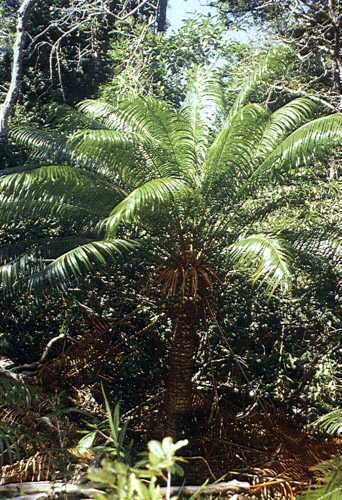Cycas silvestris
From PACSOA Wiki
| Welcome to the PACSOA Palms and Cycads wiki!
If you have any information about this species, please help by updating this article. Once you are registered you can contribute, change, or correct the text, and even add photos on this page. Click on the edit tab above and play around. Any mistake can be easily corrected, so don't be afraid. |
Cycas silvestris was described by Ken Hill in his preliminary account of the genus Cycas in Queensland(Hill 1992). The species was stated to occur on Cape York Peninsular in the vicinity of the Olive River estuary where it grows in closed forests (rainforests) on old beach dunes. The type specimen for C. silvestris was collected by J.R. Clarkson and V.J. Neldner in 1990, both botanists with the Queensland Herbarium. The first specimens of C. silvestris to be collected, were done so concurrently by B.P.M. Hyland, and L.J. Webb & J.G. Tracey, all then botanists with CSIRO, on 12 September 1974. Cycas silvestris is perhaps one of most poorly known of the Queensland species of Cycas.
Hill had not seen male cones when he described the species, and apart from the line drawings of frond segments and megasporophylls that accompany his description, there are no published photographs in the literature. C. silvestris is also unusual amongst the Queensland Cycas species, as it produces a very small male cone that is 11-13 cm long by c. 5 cm diameter with microsporophylls 20-22 mm long by 11-13 mm wide, which is considerably smaller than for the other Queensland species enumerated by Hill (1992).
The seeds are also more variable than given by Hill, with considerable differences in shape and size. From a range of about two hundred mature seeds examined in the field, the size range is 30-39 mm long and 25-32 mm wide, with some nearly globose in shape, although most are ovoid as stated by Hill. Cycas silvestris is quite a spectacular cycad and it is not uncommon to encounter individuals up to 7m in height. These are usually single-headed, although some are multi-headed, probably because of past damage to the growing tip. Some plants are more or less decumbent, perhaps as a result of storm damage causing the plants to be partially uprooted at some time in the past (Fig. 2). The foliage is glossy mid-green, and the plants are reminiscent of many taxa in the Cycas rumphii Miq. complex (Hill 1994).
Plants of C. silvestris occur generally as small groups or "cycad groves", often with a number of old mature specimens, some smaller plants an innumerable small seedlings. In nearly all instances the plants grow within the canopy of dry rainforest (Araucaria microphyll vineforest) that is characterised by emergent hoop-pines (Araucaria cunninghamii) and a rich diversity of other trees and shrubs, many also endemic to the Olive River area. This community occurs on deep sand - dunes immediately behind the foredune and for up to 2 km inland. The cycads are patchily distributed in this community, but overall are quite common in the area.
Hill (1992) stated that the conservation status of the species was 2V, i.e. vulnerable and known from a range of less than 100 km. It now appears that the distribution range of C. silvestris may be far greater than previously thought, as plants that appear identical to those at the type locality, have been found in a southern disjunct population near the Nesbit River.
While C. silvestris is abundant at the type locality, it still does not occur in a conservation reserve on Cape York Peninsula and is currently listed as VULNERABLE and subject to collector pressure (Forster 1996). Despite the difficulty of access to the habitat, there is evidence of poaching of plants (both in 1991 and in 1996), although there is no evidence of large numbers of caudices in the cycad trade. A limited number of seed and seedlings have been available in the last few years, although future offerings of this cycad will be subject to Department of Environment regulations (Forster 1996).
Cultivation of C. silvestris should be straightforward and similar to methods that produce success for species from Asia and the Western Pacific. In habitat the plants grow in white beach sand with organic matter and experience excellent drainage. Plants are tolerant of shading, although many are in full sun and seem to cope with this. Root and caudex development is extensive and seedlings should be given plenty of pot-room. There does not seem to be a marked deciduousness and flushing of the foliage as is encountered with many of the Australian Cycas species from drier habitats.
Acknowledgements[edit]
Thanks to Bruce Gray for the photographs reproduced herein, and to Peter Bostock for comments on the note.
References[edit]
Forster, P.I. (1996). A preliminary assessment of cycad
conservation and diversity in Queensland, Australia.
Encephalartos 46:8 -18.
Hill, K.D. (1992). A preliminary account of
Cycas (Cycadaceae) in Queensland. Telopea 5: 177 - 206.
Hill, K .D. (1994). The Cycas rumphii complex
(Cycadaceae) in New Guinea and the Western Pacific.
Australian Systematic Botany 7:543 - 567.
Contributed by:[edit]
Paul I. Forster, Queensland Herbarium.
Gary Beaumont (Figure 4).
Reproduced from Palms & Cycads No 52&53, Jul-Dec 1996.
External Links:[edit]
World List, IUCN, JSTOR, Trebrown, ATRP




